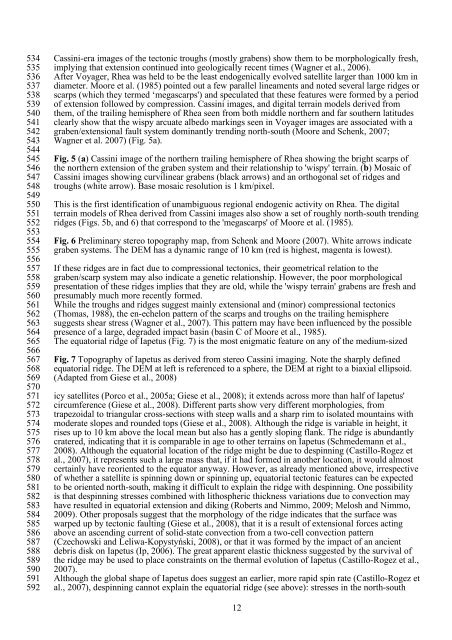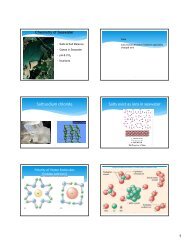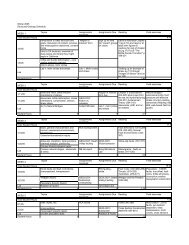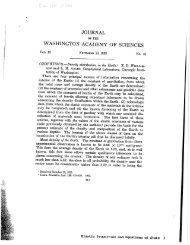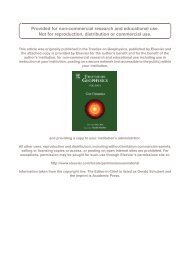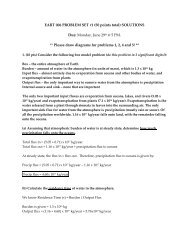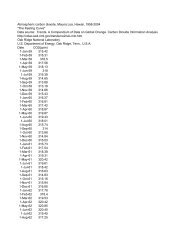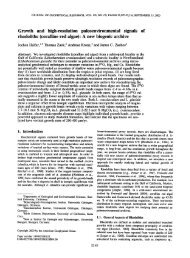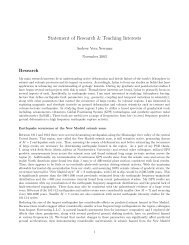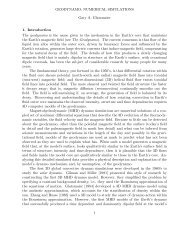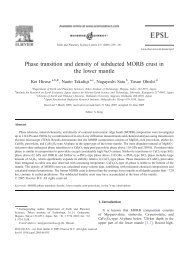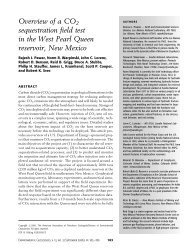Reprint - Earth & Planetary Sciences - University of California, Santa ...
Reprint - Earth & Planetary Sciences - University of California, Santa ...
Reprint - Earth & Planetary Sciences - University of California, Santa ...
Create successful ePaper yourself
Turn your PDF publications into a flip-book with our unique Google optimized e-Paper software.
534 Cassini-era images <strong>of</strong> the tectonic troughs (mostly grabens) show them to be morphologically fresh,<br />
535 implying that extension continued into geologically recent times (Wagner et al., 2006).<br />
536 After Voyager, Rhea was held to be the least endogenically evolved satellite larger than 1000 km in<br />
537 diameter. Moore et al. (1985) pointed out a few parallel lineaments and noted several large ridges or<br />
538 scarps (which they termed ‘megascarps') and speculated that these features were formed by a period<br />
539 <strong>of</strong> extension followed by compression. Cassini images, and digital terrain models derived from<br />
540 them, <strong>of</strong> the trailing hemisphere <strong>of</strong> Rhea seen from both middle northern and far southern latitudes<br />
541 clearly show that the wispy arcuate albedo markings seen in Voyager images are associated with a<br />
542 graben/extensional fault system dominantly trending north-south (Moore and Schenk, 2007;<br />
543<br />
544<br />
Wagner et al. 2007) (Fig. 5a).<br />
545 Fig. 5 (a) Cassini image <strong>of</strong> the northern trailing hemisphere <strong>of</strong> Rhea showing the bright scarps <strong>of</strong><br />
546 the northern extension <strong>of</strong> the graben system and their relationship to 'wispy' terrain. (b) Mosaic <strong>of</strong><br />
547 Cassini images showing curvilinear grabens (black arrows) and an orthogonal set <strong>of</strong> ridges and<br />
548<br />
549<br />
troughs (white arrow). Base mosaic resolution is 1 km/pixel.<br />
550 This is the first identification <strong>of</strong> unambiguous regional endogenic activity on Rhea. The digital<br />
551 terrain models <strong>of</strong> Rhea derived from Cassini images also show a set <strong>of</strong> roughly north-south trending<br />
552<br />
553<br />
ridges (Figs. 5b, and 6) that correspond to the 'megascarps' <strong>of</strong> Moore et al. (1985).<br />
554<br />
555<br />
556<br />
Fig. 6 Preliminary stereo topography map, from Schenk and Moore (2007). White arrows indicate<br />
graben systems. The DEM has a dynamic range <strong>of</strong> 10 km (red is highest, magenta is lowest).<br />
557 If these ridges are in fact due to compressional tectonics, their geometrical relation to the<br />
558 graben/scarp system may also indicate a genetic relationship. However, the poor morphological<br />
559 presentation <strong>of</strong> these ridges implies that they are old, while the 'wispy terrain' grabens are fresh and<br />
560 presumably much more recently formed.<br />
561 While the troughs and ridges suggest mainly extensional and (minor) compressional tectonics<br />
562 (Thomas, 1988), the en-echelon pattern <strong>of</strong> the scarps and troughs on the trailing hemisphere<br />
563 suggests shear stress (Wagner et al., 2007). This pattern may have been influenced by the possible<br />
564 presence <strong>of</strong> a large, degraded impact basin (basin C <strong>of</strong> Moore et al., 1985).<br />
565<br />
566<br />
The equatorial ridge <strong>of</strong> Iapetus (Fig. 7) is the most enigmatic feature on any <strong>of</strong> the medium-sized<br />
567 Fig. 7 Topography <strong>of</strong> Iapetus as derived from stereo Cassini imaging. Note the sharply defined<br />
568 equatorial ridge. The DEM at left is referenced to a sphere, the DEM at right to a biaxial ellipsoid.<br />
569<br />
570<br />
(Adapted from Giese et al., 2008)<br />
571 icy satellites (Porco et al., 2005a; Giese et al., 2008); it extends across more than half <strong>of</strong> Iapetus'<br />
572 circumference (Giese et al., 2008). Different parts show very different morphologies, from<br />
573 trapezoidal to triangular cross-sections with steep walls and a sharp rim to isolated mountains with<br />
574 moderate slopes and rounded tops (Giese et al., 2008). Although the ridge is variable in height, it<br />
575 rises up to 10 km above the local mean but also has a gently sloping flank. The ridge is abundantly<br />
576<br />
577<br />
cratered, indicating that it is comparable in age to other terrains on Iapetus (Schmedemann et al.,<br />
2008). Although the equatorial location <strong>of</strong> the ridge might be due to despinning (Castillo-Rogez et<br />
578 al., 2007), it represents such a large mass that, if it had formed in another location, it would almost<br />
579 certainly have reoriented to the equator anyway. However, as already mentioned above, irrespective<br />
580 <strong>of</strong> whether a satellite is spinning down or spinning up, equatorial tectonic features can be expected<br />
581 to be oriented north-south, making it difficult to explain the ridge with despinning. One possibility<br />
582 is that despinning stresses combined with lithospheric thickness variations due to convection may<br />
583 have resulted in equatorial extension and diking (Roberts and Nimmo, 2009; Melosh and Nimmo,<br />
584 2009). Other proposals suggest that the morphology <strong>of</strong> the ridge indicates that the surface was<br />
585 warped up by tectonic faulting (Giese et al., 2008), that it is a result <strong>of</strong> extensional forces acting<br />
586 above an ascending current <strong>of</strong> solid-state convection from a two-cell convection pattern<br />
587 (Czechowski and Leliwa-Kopystyński, 2008), or that it was formed by the impact <strong>of</strong> an ancient<br />
588 debris disk on Iapetus (Ip, 2006). The great apparent elastic thickness suggested by the survival <strong>of</strong><br />
589 the ridge may be used to place constraints on the thermal evolution <strong>of</strong> Iapetus (Castillo-Rogez et al.,<br />
590 2007).<br />
591 Although the global shape <strong>of</strong> Iapetus does suggest an earlier, more rapid spin rate (Castillo-Rogez et<br />
592<br />
al., 2007), despinning cannot explain the equatorial ridge (see above): stresses in the north-south<br />
12


